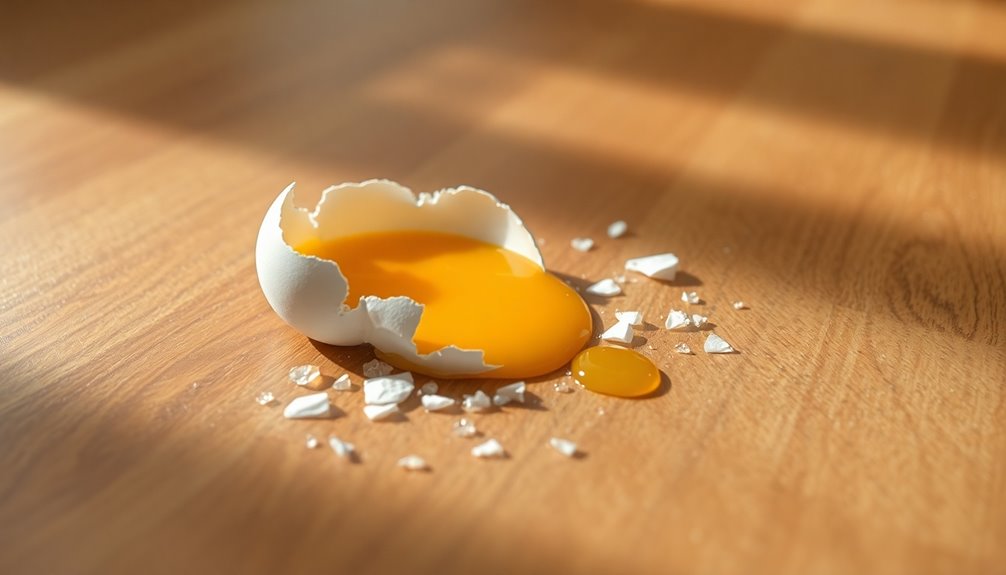When you drop an egg on the floor, it symbolizes fragility and potential. The shattered shell reflects the delicate nature of life, reminding you that everything is vulnerable. This act serves as a metaphor for personal growth; just like the egg, you too can experience a transformation after facing challenges. It encourages you to embrace the possibilities that arise from vulnerability and obstacles. Each crack exposes the inner potential, urging you to nurture growth from life's unpredictable moments. If you're curious about the deeper meanings this act holds, there's much more to explore about its cultural significance and implications.
Key Takeaways
- Dropping an egg symbolizes the fragility of life, highlighting how easily situations can shift and lead to unforeseen consequences.
- The act represents potential transformation, reminding us that even delicate things can yield new beginnings when handled with care.
- Eggs embody resilience, as their fragility necessitates protective measures, reflecting our need for support in vulnerable moments.
- This action serves as a metaphor for emotional vulnerability, illustrating how life's pressures can impact our well-being.
- Overall, dropping an egg encourages reflection on the balance between fragility and strength, reminding us to embrace growth amidst challenges.
The Symbolism of Eggs

While many might view eggs merely as a food staple, their symbolism runs deep across various cultures and traditions.
You'll find that in Ancient Greece, the Orphic Egg is said to have birthed Phanes, the primordial deity who created all other gods. Similarly, the ancient Egyptians believed that the sun god Ra hatched from a cosmic egg, linking the sun to an egg laid by a heavenly goose. Additionally, Seb, a celestial goose is credited with laying the cosmic egg in Egyptian mythology, further emphasizing the egg's divine significance. In many Indonesian households, eggs are also seen as a symbol of cultural heritage, often used in various traditional ceremonies. The significance of eggs extends to various cultural practices, including their role in merchant services that facilitate celebrations. Furthermore, the fragility of eggs serves as a reminder of the delicate balance in parenting education, where nurturing potential is essential. The importance of nurturing the potential of new life is echoed in many maternal traditions.
In Hinduism, the egg represents all of creation, with its shell symbolizing the heavens and its yolk embodying the earth.
In Chinese mythology, the cosmic egg signifies the separation of Heaven and Earth, while in the Society Islands, the creator Ta'aroa emerged from an egg that split into heaven and earth.
Beyond mythology, eggs also symbolize fertility, as seen in 17th-century France, where brides would break eggs to ensure pregnancy.
In Christianity, eggs represent the resurrection of Jesus Christ, and during Easter, they embody new life.
This universal symbolism of the egg encompasses fragility, potential, and rebirth, making it a powerful emblem in both ancient traditions and modern celebrations.
The Act of Dropping an Egg

Dropping an egg is more than just a simple act; it's a fascinating experiment that combines physics with creativity. When you let that egg fall, you're engaging with forces and momentum at play. The force exerted on the egg depends on its mass and how quickly it accelerates. By understanding impulse, you can see that extending the collision time—using materials like straws or rubber bands—can significantly reduce the force experienced by the egg. Additionally, the principles of color accuracy can be applied here, as the way light interacts with the egg's surface can affect how we perceive the drop.
To protect your egg, consider design strategies like attaching a parachute. This slows its descent and minimizes impact force. Cushioning materials such as bubble wrap or airbags can absorb shock, while suspending the egg in a cage with elastic springs disperses the energy of the fall. Additionally, employing impact reduction techniques is crucial for ensuring the egg's protection during the drop. Weather-resistant materials can be beneficial for outdoor experiments where environmental factors come into play.
You'll also want to think about orientation; landing on the egg's strongest part can make a huge difference.
As you embark on this experiment, gather basic materials like balloons or paper cups and test various protective devices. Each drop serves as a learning opportunity, revealing the intricacies of force, impulse, and energy transfer, while also connecting to real-world challenges like designing safe landers for space missions.
Understanding Fragility

Understanding Fragility
Experiments like dropping an egg illustrate the concept of fragility in a tangible way, but fragility extends far beyond simple physics. It manifests in various contexts, including states, systems, communities, and individuals.
When you consider state fragility, it's about the interplay between exposure to risks—like economic downturns or political instability—and the capacity to manage them. For example, high youth unemployment or institutional weaknesses can lead to societal unrest. Effective communication and collaboration among speech therapy professionals can significantly improve resilience in these contexts. Additionally, the ability to foster early socialization in communities can enhance adaptability and reduce vulnerability. Engaging children with educational toys that promote interaction can also build a foundation for resilience. Furthermore, addressing brain fog can provide clarity and support for individuals facing cognitive challenges, enhancing their ability to cope with stressors.
Community fragility follows similar patterns, where the breakdown of institutions or violence can arise from insufficient coping mechanisms. Emotional fragility can hinder trust and vulnerability within communities, further compounding their instability.
Emotional and psychological fragility also plays a crucial role; it reflects how easily you can become overwhelmed by stressors. You might notice this when minor worries snowball into significant anxieties.
In all these dimensions, the OECD fragility framework helps analyze the current state of fragility rather than predict future outcomes. It emphasizes the unique combinations of risks and coping capacities each context faces.
Protective Measures and Solutions

Effective protective measures are essential for safeguarding fragile items in various contexts, whether during storage, transport, or handling. Start by using high-quality packaging materials like sturdy boxes, foam, and bubble wrap. Wrap each fragile item individually in packing paper and secure it with tape. For added protection, encase items in bubble wrap before placing them in boxes. Choose box sizes that match the fragility of the products. Additionally, using firm cardboard boxes can significantly enhance protection for your fragile items. Remember to ensure that your storage area is free from any fire hazards to further protect against potential damage. Regularly checking and maintaining the condition of your packaging materials can also contribute to longer product lifespan. Moreover, consider incorporating anti-allergen technology in your packing materials to enhance protection against environmental factors. Regular maintenance of protective measures, like cleaning filters, can also help in preserving the integrity of fragile items by ensuring a stable environment.
Next, establish designated areas for fragile goods, ensuring they're separate from heavier items. Use sturdy shelves to support their weight and place the most fragile items on top shelves to avoid compression. Fill boxes with packing peanuts or crumpled paper to prevent movement.
When it comes to handling, make sure everyone's trained in safe techniques. Use personal protective equipment like padded gloves for a secure grip. Avoid impacts and drops, and utilize cushioned transport carts to minimize vibrations. Secure boxes with straps during transport to keep everything in place.
Finally, label all packaging clearly with "Fragile" and relevant handling instructions. Effective communication among team members about the presence of fragile goods is crucial for ensuring their safety throughout the process.
Cultural Significance of Eggs

Throughout history, eggs have held profound cultural significance across various societies, symbolizing fertility, creation, and potential. In ancient Greek mythology, the Orphic Egg birthed the primordial deity Phanes, embodying the genesis of gods and the earth. Similarly, in Egyptian lore, Ra hatched from a cosmic egg, while Hinduism views the egg as a representation of all creation. These myths illustrate the universal theme of eggs as symbols of life. In relationships, the fragility of an egg can also be seen as a metaphor for the emotional manipulation often experienced with narcissistic partners. The transformative approach to personal growth highlighted in positive thinking literature further emphasizes the importance of nurturing potential. Additionally, the act of nurturing is crucial for cultivating mental health and emotional resilience, reflecting the care needed to support growth. To support this nurturing aspect, many parents are encouraged to create a Montessori-inspired nursery that fosters exploration and independence in children.
In Pacific cultures, eggs also play a vital role; for instance, the creator Ta'aroa emerged from an egg that broke into heaven and earth. Additionally, eggs are seen as gateways to spiritual dimensions, enhancing their significance beyond mere physical representation.
Western practices further showcase this symbolism. In 17th-century France, brides broke eggs to ensure pregnancy, while Ukrainian Pysanka eggs were decorated to honor the sun god, linking them to fertility and seasonal celebrations like Easter.
From these diverse cultural narratives, you can see how eggs represent not just new beginnings, but also the interconnectedness of life, creation, and protection.
The egg's fragility mirrors the delicate balance of existence, emphasizing the potential for growth and transformation inherent in all living things.
Dreams and Their Meanings

Dreaming can be a fascinating window into your subconscious, revealing insights about your thoughts, emotions, and experiences. When you dream of fog, it might signal confusion or a journey into unexplored parts of your life.
If you find yourself holding keys, consider what secrets or feelings you may be locking away. Climbing a mountain in a dream could represent your determination to achieve a significant goal, while descending it may indicate overcoming challenges. Engaging with these dreams can enhance your cognitive development as you reflect on your inner thoughts and feelings. Additionally, dreams often serve as a way to process grief and loss, providing a deeper understanding of your emotional state. Understanding your emotional state can be crucial in identifying potential issues, such as emotional dysregulation that may arise in various contexts. In this sense, recognizing your dreams can contribute to building topical authority over your personal experiences.
Animals in your dreams symbolize your instinctual emotions; for instance, a cat might reflect your intuitive side, while a lion could point to repressed anger. Flying often represents a yearning for freedom or a broader perspective, whereas being chased might reveal your avoidance of certain feelings or situations. Additionally, dreaming of falling can often signify loss of control or insecurity in your waking life.
Falling can connect to real-life disappointments, and witnessing natural disasters may symbolize feeling overwhelmed. If you dream of losing limbs, think about what part of yourself feels diminished. These symbols create a rich tapestry, offering insights into your emotional landscape and encouraging you to explore your vulnerabilities and desires.
Embracing Potential and Transformation

Every individual has the potential to transform their life by embracing change and viewing challenges as opportunities. When you adopt this mindset, you start seeing change as a natural part of your journey rather than a threat.
Approach obstacles with curiosity and openness, recognizing that setbacks can serve as stepping stones toward personal and professional growth. By reframing challenges as opportunities for learning, you unlock new possibilities and foster excitement for what lies ahead. Embracing change enhances your ability to navigate through life's uncertainties with confidence. Additionally, implementing effective relaxation techniques can significantly improve your emotional resilience during challenging times. Sleep serves as a tool for aligning with desired realities, allowing for greater clarity and focus as you tackle life's hurdles. Regular health checks can also help maintain your overall well-being, enabling you to face challenges with a clear mind.
Cultivating resilience is crucial in this process. Understand that failure is just a temporary setback and not a reflection of your worth. Draw strength from adversity, gaining valuable insights that propel you forward.
Building resilience involves nurturing self-awareness and developing strong coping mechanisms, alongside a supportive network that enhances your ability to bounce back. Techniques for maintaining high vibrational energy can also support your journey toward resilience and growth.
Embracing a growth mindset is essential as well. Believe that your abilities can improve with effort and practice. Challenges then become chances to stretch your capabilities and learn new skills.
Frequently Asked Questions
How Can I Prevent Eggs From Breaking During Transport?
To prevent eggs from breaking during transport, use dedicated egg containers that secure each egg in individual compartments.
Wrap each egg in bubble wrap or paper towels for extra cushioning.
Make sure to store the container in the coolest part of your backpack or cooler, and avoid placing it near sharp objects.
You can also consider using liquid eggs as a safer alternative.
Always keep the container stable to minimize movement.
What Are Some Creative Egg-Related Crafts for Children?
You can create some fun egg-related crafts for children!
Try making handprint bunny egg holders by tracing and cutting out handprints to form bunny shapes.
Marbled decorative eggs are a colorful option, using shaving foam and food coloring for a unique design.
Another idea is to design chocolate egg holders with decorated handprints.
These crafts aren't only enjoyable but also allow kids to express their creativity while celebrating Easter!
Are There Specific Egg Types With Different Symbolic Meanings?
Absolutely! Different egg types carry unique symbolic meanings.
For instance, chicken eggs often symbolize fertility and new beginnings, while ostrich eggs can represent strength and protection due to their size and durability.
Quail eggs might signify abundance and prosperity.
Each type offers a distinct perspective on potential and transformation, reflecting various aspects of life and creation.
How Do Different Cultures Celebrate With Eggs?
Different cultures celebrate with eggs in unique ways.
In Jamaica, you might crack eggs on Good Friday to predict your future.
If you're in Mexico, you could fill hollow eggs with confetti and break them for good luck.
In Greece, you'd use red eggs symbolizing Christ's blood.
Meanwhile, in Germany, people smear eggs on ploughs as fertility rites.
Each tradition reflects the egg's rich symbolism across various societies, making celebrations special and meaningful.
What Nutritional Benefits Do Eggs Offer in Our Diet?
Eggs offer incredible nutritional benefits that you can easily incorporate into your diet.
Each egg packs about 6-7 grams of high-quality protein, essential for muscle synthesis and overall health. They're rich in vitamins and minerals, including choline, which supports brain function.
Plus, eggs can help manage your weight by keeping you full longer. With their low carbohydrate content, they're also a great choice for those watching their glycemic index.
Enjoy their versatility!
Conclusion
In dropping an egg, you're not just making a mess; you're touching on deeper themes of fragility and potential. It's a reminder that life's delicate moments can lead to transformation and growth. Embrace the lessons learned from those slips and spills. They can guide you toward understanding your own strength and the beauty of new beginnings. So, next time an egg drops, think of it as an opportunity to reflect on the possibilities that lie ahead.











